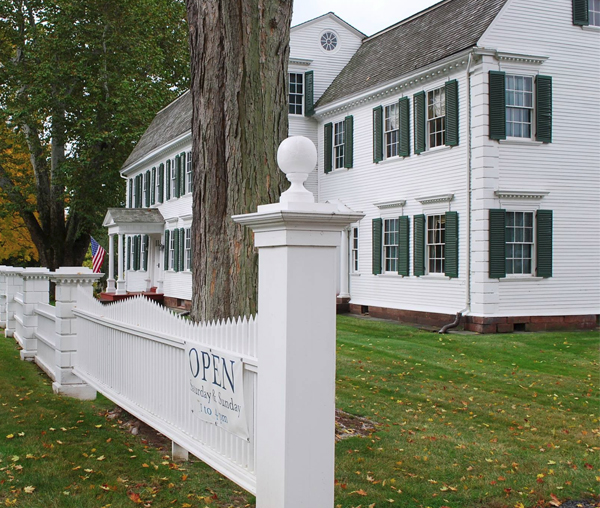Phelps-Hatheway House & Garden
55 South Main Street, Suffield, CT 06078
(860) 668-0055
Summer Weather Advisory
Our historic property is not climate controlled. Staff may adjust the route, duration, and schedule of tours due to higher temperatures or extreme weather. Please contact us before your visit to confirm operations. Learn more »
Phelps-Hatheway House & Garden
55 South Main Street, Suffield, CT 06078
(860) 668-0055
Summer Weather Advisory
Our historic property is not climate controlled. Staff may adjust the route, duration, and schedule of tours due to higher temperatures or extreme weather. Please contact us before your visit to confirm operations. Learn more »
Admission
$15/Adult
$12/Senior, Student, or Teacher
$5/Child 6-18
Free for Connecticut Landmarks Members & Children under 6
House Tour
Examine the lives and experiences of the first two owners of the Phelps-Hatheway House, Shem Burbank and Oliver Phelps. Although the two lived during the same period, they experienced the events of the late 18th century in very different ways. How did their political views and the opportunities they pursued during the American Revolution change their fortunes – or lack thereof? Understand the role of Connecticut in the American Revolution, examine Colonial era trade and commercial exchange, consider land and real estate speculation and Indigenous people’s land rights, and consider the ways we display wealth and status.

LEARN MORE
The Phelps-Hatheway House & Garden highlights the luxurious lifestyle enjoyed by two wealthy 18th-century Connecticut Valley families until their fortunes collapsed. Suffield native Shem Burbank built the center chimney structure in 1761 where he and his wife Anna Fitch Burbank raised nine children. Due to the unstable national economy during and after the American Revolution, the family’s financial situation suffered.
In 1788, he sold the house to Oliver Phelps originally of Windsor, who served as Deputy Commissary under George Washington. In 1794, Phelps commissioned the addition of a substantial wing decorated with imported Parisian wallpaper. The contrasts between the two sections of the house further highlight the differences between Burbank’s and Phelps’ personalities, experiences, and times. Later, Phelps tried to sell significant swaths of land that belonged to members of the Seneca Nation as part of Connecticut’s Western Reserve. When a precarious market made him lose his property in 1802, he moved to Canandaigua, NY, where he died in 1809.
The Hatheway family took possession of the house from the early 1800s to 1914, accumulating an attic full of artifacts that document life from that time. Sumner Fuller and his mother Emma carefully preserved the property which was donated to the Antiquarian & Landmarks Society (now CTL) upon Mrs. Fuller’s death in 1956. Today, the museum boasts an extensive collection of 18th-century antiques while the grounds feature a Colonial Revival Garden installed by landscape architect Mary Wells Edwards in 1964, a large herb bed, and scattered flowering shrubs, all lovingly maintained by the Suffield Garden Club.
LEARN MORE
The Phelps-Hatheway House & Garden highlights the luxurious lifestyle enjoyed by two wealthy 18th-century Connecticut Valley families until their fortunes collapsed. Suffield native Shem Burbank built the center chimney structure in 1761 where he and his wife Anna Fitch Burbank raised nine children. A merchant of British goods, Burbank’s business suffered during the American Revolution.
In 1788, he sold the house to Oliver Phelps originally of Windsor, who served as Deputy Commissary under George Washington. In 1794, Phelps commissioned the addition of a substantial wing decorated with imported Parisian wallpaper. The contrasts between the two sections of the house further highlight the differences between Burbank’s and Phelps’ personalities, experiences, and times. Later, Phelps attempted to sell significant swaths of land that had belonged to members of the Seneca Nation as part of Connecticut’s Western Reserve. When a precarious market made him lose his property in 1802, he moved to Canandaigua, NY, where he died in 1809.
The Hatheway family took possession of the house from the early 1800s to 1914, accumulating an attic full of artifacts that document life from that time. Sumner Fuller and his mother Emma carefully preserved the property which was donated to the Antiquarian & Landmarks Society (now CTL) upon Mrs. Fuller’s death in 1956. Today, the museum boasts an extensive collection of 18th-century antiques while the grounds feature a Colonial Revival garden installed by landscape architect Mary Wells Edwards in 1964, a large herb bed, and scattered flowering shrubs, all lovingly maintained by the Suffield Garden Club.

